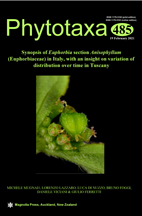Abstract
We present an updated taxonomic study of Euphorbia sect. Anisophyllum (Euphorbiaceae) for Italy. A comprehensive body of knowledge has been developed thanks to the examination of about 1,250 herbarium specimens from 13 Italian herbaria, field surveys, and an extensive literature analysis. As a result, our revision included 10 species considered as currently occurring in Italy, of which 2 native (Euphorbia chamaesyce and E. peplis) and 8 alien (E. glyptosperma, E. humifusa, E. hypericifolia, E. maculata, E. nutans, E. ophthalmica, E. prostrata, and E. serpens). The revision included also additional 5 species previously erroneously recorded in Italy (E. berteroana, E. engelmannii, E. hyssopifolia, E. indica, and E. thymifolia) and other two species (E. hirta and E. humistrata) not occurring in Italy but closely related to recorded species and already established and considered as alien species in other countries. Current distribution and status at the regional level is updated for 7 species (E. berteroana, E. engelmannii, E. humifusa, E. hypericifolia, E. indica, E. nutans, and E. prostrata) and typification of 18 names (Chamaesyce glomerifera, E. boliviana, E. bracteolaris, E. brasiliensis, E. chamaesyce var. maculata, E. engelmannii, E. humifusa, E. hypericifolia var. communis, E. indica, E. klotzschiana, E. nutans, E. peplis, E. perforata, E. pinnulosa, E. preslii, E. procumbens, E. reichenbachiana, and E. trichogona) is also provided. For all taxa we report information about nomenclature, morphology, ecology, chorology, distribution, taxonomy, as well as an identification key for species identification and original photos. In addition, we provided a detailed statement of species of the section for Tuscany and we performed an analysis of distribution variation of different species over time in this region. Our results evaluate the current state of E. sect. Anisophyllum in Italy and highlight the presence of fluxes in densities of different species populations. In particular, a reduction of native and formerly colonizing species and an increase of more recently colonizing species is recorded.

